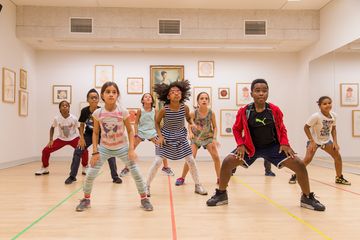Some of my first memories of sitting in the audience at the New York City Ballet at Lincoln Center are of Jacques d’Amboise. Even as a young child, I recognized his grace and brilliance as a dancer. My Mom and I followed him and his career for decades. In addition to seeing him on stage, we went to hear him speak on various occasions, and after he retired from dancing, we enjoyed the ballets that he choreographed... and then were overjoyed to watch his son Christopher literally follow in his footsteps. We were elated when Jacques won an Academy Award for He Makes Me Feel Like Dancin' in 1984 and cheered him on when he founded the National Dance Institute (NDI) in 1976. In the early 2000s, I was thrilled to be able to arrange to have the students from his organization perform at my own children’s school. Today, his art education program at NDI has reached approximately 6, 500 children throughout the New York City school system by bringing dance and music into young people's lives. Over the course of the six years that I have spent walking the side streets of Manhattan, I have had the extreme pleasure of meeting thousands of people who have each touched me in a unique way. I have been transfixed by every word of their stories and honored to be able to share them on the Manhattan Sideways website. Sitting down next to Jacques d’Amboise when I neared the top of the Manhattan grid brought tears to my eyes - it was certainly a highlight of my journey. At eighty-three years old, he was everything and more of the man that had left such a deep impression on me some forty-five years before. He is a genuine human being with a deep compassion for others, a strong desire to continue to make the world a better place through art and dance, and the ultimate New Yorker. When I mentioned my childhood memories and told him how my parents had been attending performances at New York City Ballet almost since the beginning, he began reminiscing and spoke fondly of Lincoln Kirsten and George Balanchine, the founders. As he started sharing stories of his time spent in Russia, one of the Manhattan Sideways photographers, Olga, walked in. Jacques became giddy when he learned that she had grown up in Odessa and had studied ballet. After our marvelous encounter with Jacques, we proceeded down the stairs of NDI to where all the action happens. What was once a public school has now become a dance center with multiple classrooms and a 100-seat theater for performances. If one did not know, however, that one were in a dance studio, one might think this was a spectacular art gallery. As I learned from the enthusiastic staff members, Jacques loves immersing himself in beauty, and he wants his students to be surrounded by it as well. Whenever he travels around the world, he comes back with something extraordinary. In addition to the array of pieces by a diverse number of artists, there is also a wonderful wall of photographs of Jacques that his wife took over the years. Before dashing off to a tap class, Mary Kennedy, a Master Teaching Artist since 2000, spoke briefly with me. She explained that every year, the staff decides on a different theme for the season. In 2017, they were concentrating on rivers. Not only are the various dances that are choreographed integrated into the related theme, but lessons about the subject are also given. When I inquired if she ever "joins" a class, she responded with a smile and said, "I always enjoy learning and participating, so sometimes I, too, take a class with the kids. I still feel like a child. It is fun to mirror them. This way we have a team experience. " I then asked Mary if there was one thing that she could share with me about working with Jacques over the past seventeen years. Her reply was simple: "Because of Jacques' vision, all of us are able to live his dream. He has given us the opportunity to bring joy to so many through movement and dance. "Other staff members elaborated on some of what Mary had shared. They explained that they send teaching artists and musicians into the schools to identify and decide who is invited into their programs. "We would like to take everyone, but we obviously cannot do this. " They assured me, however, that children can still come and take classes. When I commented on what the students were wearing, I learned that they are encouraged to come in comfy clothing and sneakers. It is one of the few places where traditional ballet is taught where proper dance attire is not required. NDI has a need-based scholarship program for the weekly classes, which are offered to kindergartners through eighth graders. On Saturdays, when around 200 children come to NDI, I was told that it is "electric. " A staff member explained, “You can always feel the energy - it bounces off of you. We cannot describe what goes on here: Everyone needs to experience it. ” All of this is immediately apparent upon stepping inside the National Dance Institute. One can see the smiles on the children’s faces, the gratitude of the parents, and the absolute joy that the teachers experience every day working with Jacques, who is clearly an incredible man. Jacques d’Amboise is a legend and a hero not only in New York but around the country and throughout the world. He wants each child to succeed, and he has created an environment that helps them excel. His goal is pure and simple - instilling the desire in kids to be the best that they can be. What better way to do this than through dance? His philosophy is not only that children can potentially become dancers, but that they can master many other challenges in their lives. As Traci Lester, the Executive Director, expressed to me, “If you surround children with the best, then they will shine. Jacques sets the standard. Give them high expectations and they will rise. " She added, "Everything is about Jacques. He is what sets us apart from other art education programs. He is a catalyst for change. He inspires every one of us. "

